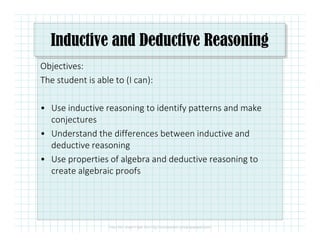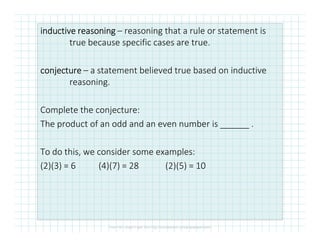1.3.2 Inductive and Deductive Reasoning
- 1. Inductive and Deductive Reasoning Objectives: The student is able to (I can): • Use inductive reasoning to identify patterns and make conjecturesconjectures • Understand the differences between inductive and deductive reasoning • Use properties of algebra and deductive reasoning to create algebraic proofs
- 2. Find the next item in the sequence: 1. December, November, October, ... 2. 3, 6, 9, 12, ... 3. , , , ... 4. 1, 1, 2, 3, 5, 8, ...
- 3. Find the next item in the sequence: 1. December, November, October, ... SeptemberSeptemberSeptemberSeptember 2. 3, 6, 9, 12, ... 15151515 3. , , , ... 4. 1, 1, 2, 3, 5, 8, ... 13131313 –––– This is called the Fibonacci sequence.This is called the Fibonacci sequence.This is called the Fibonacci sequence.This is called the Fibonacci sequence.
- 4. inductiveinductiveinductiveinductive reasoningreasoningreasoningreasoning – reasoning that a rule or statement is true because specific cases are true. conjectureconjectureconjectureconjecture – a statement believed true based on inductive reasoning. Complete the conjecture: The product of an odd and an even number is ______ .The product of an odd and an even number is ______ . To do this, we consider some examples: (2)(3) = 6 (4)(7) = 28 (2)(5) = 10
- 5. inductiveinductiveinductiveinductive reasoningreasoningreasoningreasoning – reasoning that a rule or statement is true because specific cases are true. conjectureconjectureconjectureconjecture – a statement believed true based on inductive reasoning. Complete the conjecture: The product of an odd and an even number is ______ .evenevenevenevenThe product of an odd and an even number is ______ . To do this, we consider some examples: (2)(3) = 6 (4)(7) = 28 (2)(5) = 10 eveneveneveneven
- 6. Examples To Use Inductive Reasoning 1. Look for a pattern. 2. Make a conjecture. 3. Prove the conjecture or find a counterexample to disprove it. Show that each conjecture is false by giving a counterexample.a counterexample. 1. The product of any two numbers is greater than the numbers themselves. 2. Two complementary angles are not congruent.
- 7. Examples To Use Inductive Reasoning 1. Look for a pattern. 2. Make a conjecture. 3. Prove the conjecture or find a counterexample to disprove it. Show that each conjecture is false by giving a counterexample.a counterexample. 1. The product of any two numbers is greater than the numbers themselves. ((((----1)(5) =1)(5) =1)(5) =1)(5) = ----5555 2. Two complementary angles are not congruent. 45º and 45º45º and 45º45º and 45º45º and 45º
- 8. Sometimes we can use inductive reasoning to solve a problem that does not appear to have a pattern. Example: Find the sum of the first 20 odd numbers. 1 1 + 3 1 + 3 + 5 1 4 9 Sum of first 20 odd numbers? 1 + 3 + 5 1 + 3 + 5 + 7 9 16
- 9. Sometimes we can use inductive reasoning to solve a problem that does not appear to have a pattern. Example: Find the sum of the first 20 odd numbers. 1 1 + 3 1 + 3 + 5 1 4 9 12 22 32 Sum of first 20 odd numbers? 1 + 3 + 5 1 + 3 + 5 + 7 9 16 32 42 202 = 400
- 10. These patterns can be expanded to find the “nth” term using algebra. When you complete these sequences by applying a rule, it is called a functionfunctionfunctionfunction. Examples: Find the missing terms and the rule. 1 2 3 4 5 … 8 … 20 … n -3 -2 -1 0 1 To find the pattern when the difference between each term is the same, the coefficient of n is the difference between each term, and the value at 0 is what is added or subtracted. 1 2 3 4 5 … 8 … 20 … n 32 39 46 53 60
- 11. These patterns can be expanded to find the “nth” term using algebra. When you complete these sequences by applying a rule, it is called a functionfunctionfunctionfunction. Examples: Find the missing terms and the rule. 1 2 3 4 5 … 8 … 20 … n -3 -2 -1 0 1 4 16 n – 4 To find the pattern when the difference between each term is the same, the coefficient of n is the difference between each term, and the value at 0 is what is added or subtracted. 1 2 3 4 5 … 8 … 20 … n 32 39 46 53 60 81 165 7n+25
- 12. deductivedeductivedeductivedeductive reasoningreasoningreasoningreasoning – the process of using logic to draw conclusions from given facts, definitions, and properties. Inductive reasoning uses specific cases and observations to form conclusions about general ones (circumstantial evidence). Deductive reasoning uses facts about general cases to form conclusions about specific cases (direct evidence).
- 13. Example Decide whether each conclusion uses inductive or deductive reasoning. 1. Police arrest a person for robbery when they find him in possession of stolen merchandise. 2. Gunpowder residue tests show that a2. Gunpowder residue tests show that a suspect had fired a gun recently.
- 14. Example Decide whether each conclusion uses inductive or deductive reasoning. 1. Police arrest a person for robbery when they find him in possession of stolen merchandise. Inductive reasoningInductive reasoningInductive reasoningInductive reasoning 2. Gunpowder residue tests show that a2. Gunpowder residue tests show that a suspect had fired a gun recently. Deductive reasoningDeductive reasoningDeductive reasoningDeductive reasoning
- 15. Transitive Property of Equality • If a = b, and b = c, then a = c. • Ex: If 1 dime = 2 nickels, and 2 nickels = 10 pennies, then 1 dime = 10 pennies. Substitution Property of Equality • If a = b, then b can be substituted for a in any expression. • Ex: If x = 5, then we can substitute 5 for x in the equation• Ex: If x = 5, then we can substitute 5 for x in the equation y = x + 2, which means y = 7. We will also use the Distributive Property: a(b + c) = ab + ac and ab + ac = a(b + c)
- 16. proofproofproofproof – an argument which uses logic, definitions, properties, and previously proven statements to show that a conclusion is true. algebraic proofalgebraic proofalgebraic proofalgebraic proof – a proof which uses algebraic properties When you write a proof, you must give a justification (reason) for each step to show that it is valid. For each(reason) for each step to show that it is valid. For each justification, you can use a definition, postulate, property, or a piece of given information.
- 17. Ex.: Solve the equation x – 1 = 5, and write a justification for each step. x – 1 = 5 Given x – 1 + 1 = 5 + 1 Addition prop. = x = 6 Simplify Ex: Solve the equation 4m + 8 = –12, and write the justification for each step.justification for each step. 4m + 8 = –12 Given 4m + 8 – 8 = –12 – 8 Subtraction prop. = 4m = –20 Simplify Division prop. = m = –5 Simplify − = 4 20 4 4 m
- 18. As a general rule, we do not write out the actions that we use to solve the equation, we just write the result of each action. Example: Solve the equation 4x = 2x + 8. Write a justification for each step. 4x = 2x + 8 Given equation 2x = 8 Subtraction prop. =2x = 8 Subtraction prop. = x = 4 Division prop. =
- 19. We can also apply the definitions and properties we learned in Chapter 1: Solve for x and write a justification for each step. MY = MA + AY Segment Addition Postulate ● M A Y 9x – 4 5x + 7 2x + 3 MY = MA + AY Segment Addition Postulate 9x – 4 = 5x + 7 + 2x + 3 Substition prop. = 9x – 4 = 7x + 10 Simplify 9x = 7x + 14 Addition prop. = 2x = 14 Subtraction prop. = x = 7 Division prop. =


















